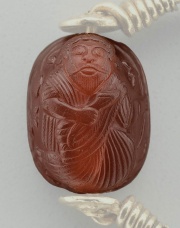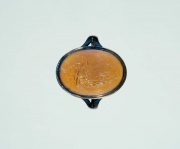Sard
Revision as of 12:01, 27 April 2013 by (username removed)
Description
A translucent orange to reddish-brown form of chalcedony. Sard is darker than carnelian, but otherwise a similar stone. Both have been mined or gathered since at least 3000 BCE. Water-worn pebbles of sard are found in Egypt, India, and several areas of Europe. It was popular for amulets and scarabs.
Synonyms and Related Terms
chalcedony; sardius; sardoine; sardine
Other Properties
Fracture = conchoidal. Luster = vitreous to waxy. Streak = white
| Mohs Hardness | 7.0 |
|---|---|
| Density | 2.6 |
Additional Information
Mineralogy Database: Quartz
Comparisons
Properties of Common Gemstones
Authority
- Jack Odgen, Jack Odgen, Jewellery of the Ancient World, Rizzoli International Publications Inc., New York City, 1982
- A.Lucas, J.R.Harris, A.Lucas, J.R.Harris, Ancient Egyptian Materials and Industries, Edward Arnold Publishers Ltd., London, 4th edition, 1962
- C.W.Chesterman, K.E.Lowe, C.W.Chesterman, K.E.Lowe, Audubon Society Field Guide to North American Rocks and Minerals, Alfred A. Knopf, New York, 1979
- Wikipedia, the free encyclopedia, at http://www.wikipedia.com Comment: http://en.wikipedia.org/wiki/Sard (Accessed Nov. 9, 2005)
- G.S.Brady, G.S.Brady, Materials Handbook, McGraw-Hill Book Co., New York, 1971 Comment: p. 22
- Random House, Random House, Webster's Encyclopedic Unabridged Dictionary of the English Language, Grammercy Book, New York, 1997
- The American Heritage Dictionary or Encarta, via Microsoft Bookshelf 98, Microsoft Corp., 1998

